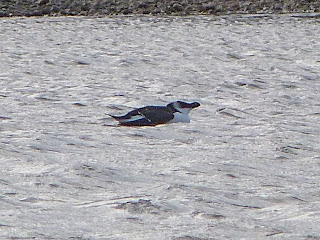It's been awhile since my last blog but there really hasn't been much to report until this week!
We have, however, managed to trap and ring a few ducks in the decoy for the first time in two years. The lack of decoying has largely been due to the disturbance caused by The Decoy Restoration Project but at least now that it's almost complete will will have a decoy pond for hopefully many years to come. Unfortunately all the duck caught so far this year have been Mallards...
 |
| Male Mallard fresh out of the sack... |
 |
| ....and gaining a shiny new ring |
 |
| It's then aged and it's wing is measured... |
 |
| then its skull/bill... |
 |
| then weighed and then released. |
Although we have only managed to trap a few Mallard there have been a nice selection of the commoner ducks and other wetland species present, albeit in small numbers, as the results of The Swannery January Wetland Bird Survey reveal....
Mute Swan 375
Canada Goose 1
Shelduck 39
Wigeon 2
Teal 610
Mallard 377
Mallard (domestic) 9
Shoveler 45
Pochard 486
Tufted Duck 220
Scaup 1
Goldeneye 20
Red-breasted Merganser 25
Cormorant 1
Little Egret 2
Little Grebe 7
Great Crested Grebe 3
Moorhen 10
Coot 290
Oystercatcher 2
Lapwing 435
Snipe 4
Redshank 5
Black-headed Gull 40
Little Gull 1
Mediterranean Gull 2
Common Gull 4
Herring Gull 13
Great Black-backed Gull 8
Kingfisher 1
The Little Gull (just about annual at The Swannery) was the count highlight but unfortunately I missed it, as while count volunteers Alan and Mike were watching it at The Swannery I was still counting just to the east toward Rodden Hive Point. Not all the wildfowl and waders seen in the last few weeks were seen on the count though.
 |
| There have been a few Gadwall.... |
 |
| and Pintail |
 |
| Some of the 35 Redshank. |
There has also been two different Marsh Harriers but the rarest sighting in the context of The Swannery was definitely this Razorbill...
 |
| Razorbill (winter) on The Fleet by the tank traps. |
Although relatively common on the seaward side of Abbotsbury Beach this is only around the third seen at The Swannery end of The Fleet lagoon in over twenty years. This despite guillemots being nearly annual on my patch and Little Auks being almost common in comparison!
I still need Puffin and Black Guillemot for the set though!
 |
| 'A Roe in the Reeds'... Roe Deer... the most regular deer species at the Swannery - in fact it was my only deer species there until Sikas arrived around ten years ago. |




